
With a clever blend of wool and down insulation, this sleeping bag range from German brand Grüezi offers something a bit different from the norm. When it comes to performance in damp conditions, DownWool has a big advantage, reckons Toby Archer.
This is an unusual sleeping bag from a brand we've not covered before, and one with plenty to like. There are lots of interesting things to say about the Grüezi Biopod DownWool Summer 175 sleeping bag, and we'll come on to each in good time. Let's start with the obvious and most interesting subject - the stuff it's stuffed with.
DownWool - what's that?
The unique feature of the Grüezi bags is DownWool insulation. This is exactly what it sounds like - a blend of down and wool. More precisely, Grüezi have mixed 650+ fill power, RDS-certified, down with wool - in a 70/30 percent ratio of down to wool.
But why? Well the reasoning seems predominantly about moisture management, be that perspiration from inside or dampness from your bivvy or tent on the outside. They note that wool can absorb up to 30 percent of its own weight in water without losing its insulating properties, but most importantly the wool will attract and hold any moisture in the insulation, keeping the down dry and allowing it to insulate as efficiently as we all know down does when dry. The wool also means that Grüezi doesn't need to treat the down with any chemical water repellents, and indeed the whole bag is PFC-free.
The name tells you a lot
In this review we're looking at the Grüezi Biopod DownWool Summer 175, part of an extensive DownWool range - and the long name is useful because it's so explanatory.
Google tells me that "Grüezi!" is the cheery greeting "Good Morning!" in Swiss German which is just a lovely name for a company making sleeping bags (at UKC Towers we await an Aussie sleeping bag manufacturer called "G'day Mate!").
DownWool seems to work well - especially in damp conditions
The "DownWool" tells you perhaps the most interesting bit about the bag.
Then we get to the "Summer"- no messing about, this is a sleeping bag for the warmer parts of the year and designed accordingly. For colder conditions you could have a DownWoll SubZero, or an Ice, or an Extreme bag - each doing what they say on the tin. Or you could go ultralight for warmer weather with an Extreme Light.
"175" is simply the length of the bag in centimetres. If you are a bit taller you'll want a 185 sleeping bag, and for the really tall there's a 200 version too. Helpfully for those of us who are 175cm tall (about the average for British men) or less (the majority of British women), is that of the three lengths of the Biopod DownWool Summer bag, the 175 is the cheapest. I may not be able to reach the holds that my lanky climbing partners can, but finally here's a small benefit to being a short-arse!
So, the name of the Grüezi Biopod DownWool Summer 175 sleeping bag does give a really good idea of what this bag is like, but there are a lot more details of the design of the bag, and its performance in use - and generally it's all positive. Overall, the DownWool Biopod Summer is a bag that it's really easy to like.
In use
Grüezi claims "wool is very temperature regulating and creates a pleasant microclimate in a natural way" and that the wool/down mix allows for a wider comfort range temperature than a bag insulated by down alone. Claims about "feel" are invariably hard to test but I have been pleased with the bag's performance across a range of conditions, including after multiple and long days in the saddle. Grüezi do make warmer bags, but the DownWool Summer gets me comfortably to within a few degrees of freezing. Obviously you can push any bag's limit by wearing more inside or draping jackets over, but on its own the DownWool Summer seems perfectly designed from the coolest of British summer nights to the warmest, plus with some useful crossover into spring and autumn.
I've used the bag in a single skin bivvy-tent. During the night I was woken by rain, so closed the tent door, meaning the ventilation was down to the minimum. As normal there was plenty of condensation in the morning inside and the bag would have touched the wet walls, but it didn't feel damp at all. If that's the wool in the insulation dealing with moisture, then it seems to work well.
The EN 23537 rating for the DownWool Summer is - Comfort: 8°C, Comfort Limit: 3°C and Extreme: -11 °C. The extreme rating can be ignored, but I have used the bag twice where I suspect I was at, or only a couple of degrees above, the comfort limit. On both nights I slept well, although on a windy bivvy under an open-sided tarp I wore a light hat and fleece in the bag. On both of those trips I had neglected to bring any longjohns to use as pyjamas, so slept in just shorts. I do remember on cold nights camping in the past, that sometimes it is my thighs that have gotten unpleasantly cool and woken me up. No such problems with the Grüezi bag, even without 'pyjamas' and in low single figure temperatures, I was warm enough.
I took the bag with me when, at the end of August, I bikepacked the Rebellion Way, a 374km back-lanes and off-road trail around Norfolk. My first night was up on the north coast. After a hot and sweaty 125km the night was clear and great for stars but the temperature did drop rapidly. Zipped up in the Grüezi I slept soundly, not stirring until the rising sun warmed my tent. Subsequent nights were warmer, but I slept well without getting too hot either by just not putting my head in the hood or unzipping the bag down at the base and popping my feet out. Feeling cooler in the early hours as I often do, I would just close the zip or pull the hood over my head.
Design
Superficially the DownWool Summer looks much like other well designed modern mummy-shaped sleeping bag; but look closer and a few points stand out.
Firstly the curving and double ended zip is interesting. The curve has been used so that you can open the bottom and pop your feet out if you are getting a bit warm on those balmy summer nights. I've tried it and it works well. Of course you can open the zip from the top and flip the bag open as well, but a bit of foot-cooling works well if you still want some insulation over your midriff. The zip puller is also a clever one I haven't seen before, designed to stop it snagging on the nylon of the bag. It's not infallible but, along with anti-snag strips along the zip, it definitely helps.
Like many summer bags, this model doesn't have a draft collar, but it does have an easily cinched-up hood that makes the bag considerably more efficient on nights at the bottom of its comfort range.
One great feature with the bag's hood is an extra layer of nylon, open at one end, at the back of the hood. Scrunch up some clothing, push it into this envelope, and you have an instant pillow. Genius! I suspect this isn't the only bag to do this, but after what must be 50 years of camping, it's the first bag I've ever used with this build-your-own-pillow feature. Indeed, this summer I was finally going to buy one of those ultralight inflatable pillows to take with me on a multi-day bikepack. But after the first use of the Grüezi bag, and instantly loving the pocket-pillow, I saved my money.
The bag also has two pockets. There's a velcro-closed one inside above your chest, and a zipped one on the outside. Both are insulated, making them good places to keep your phone battery warm on cool nights. They are layered one over the other, so you won't want to load them both up too much. Which you use perhaps comes down to whether you prefer to get to your phone, headtorch, or watch from inside or outside.
The inner and outer of the bag is all nylon, which does it job very well - perfectly comfy next to the skin, and repelling the odd drip from a tent or spill while eating breakfast. One thing worthy of note: compared to most other down bags, this one does not seem to ever leak feathers. Whether this is something to do with the nylon shell or from mixing the down with wool, I don't know.
One significant design feature which Grüezi don't mention on their website, is that the bag is a box-wall construction rather than stitched through. Creating box-wall baffles avoids the cold spots you get with stitched-through construction, but it involves much more complicated sewing. The owner of another small sleeping bag manufacturer once told me he believes that all good sleeping bags must be box-wall designs, so I would argue this shows that Grüezi are by default making performance sleeping bags.
The bag has hanging tags inside and out to help air it, or even store it if you have the space to hang it vertically; it also comes with a four-strap, spider-style compression sack and a large, part-mesh sack for storing the bag uncompressed.
Weight
My bag weighs 845g, with the compression sack adding another 77g. Grüezi's own website gives an approximate weight of 750g. The "approx" is doing a lot of work in this case because 95g is a considerable difference in a bag well under a kilo. Grüezi aren't selling the bag as an ultralight model, rather as a comfortable bag across a range of summer conditions, and as a down bag that can deal with dampness in the environment better than some others. Perhaps the use of wool as insulation adds some unpredictability to the final weight of individual bags, but understating the weight by more than 10% for a product where for many buyers the weight is a central consideration, isn't ideal.
I have used two sleeping bags that are lighter (almost half the weight in one case) that also have slightly lower comfort limit ratings, but they reach those figures by using exceedingly high fill-power (and therefore expensive) down, and by compromising on things like only three quarter length zips and no extra features. The lightest bag I have has a differential fill with minimal down in the base - fine if you sleep on your bag and don't move, but if you are a side-sleeper and the bag moves with you, your back can quickly get noticeably colder.
The Grüezi bag makes no such compromises: roll over, and you'll be just as warm. End up with your feet against the sopping side of your tent or bivvy, or slide down your ground sheet until your feet are protruding from under your tarp and resting on dew-covered bilberry bushes(!), and the wool in the insulation will deal with the dampness. Use it for multiple nights in a row and worry less about "insulation collapse" where the down eventually gets damp enough to suddenly not work properly. And on multi day trips, you can sleep comfortably all zipped up on cold nights, and just as comfortably with feet and head protruding on subsequent warmer nights.
Ethics and environment
Grüezi as a brand makes a virtue of its high ethical and environmental standards. Their products are PFC-free; the down is RDS-certified; and the wool comes form European producers (with the highest welfare standards in the world).
Conclusion
A bit like taking a slightly heavier but more spacious tent for a multi-day trip, the slightly heavier and bulkier Grüezi bag is a compromise that many backpackers, bikepackers and camping-climbers will be able to easily live with. Retailing at £299 for the summer bag reviewed here, there are of course cheaper down bags available - but the price is competitive for a box-wall, performance down bag, even leaving aside the novel hybrid insulation, and the advantages that it brings. DownWool is an interesting concept, and one that really does seem to work well - especially in damp conditions. Overall I'd say there's a lot to like here!

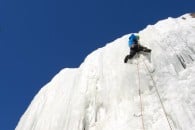



















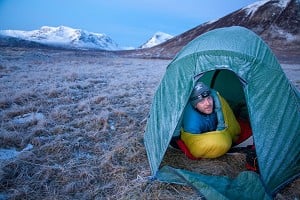
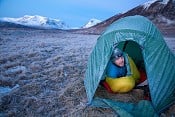
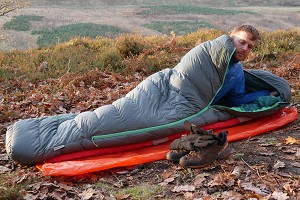
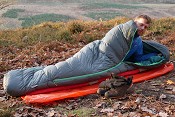
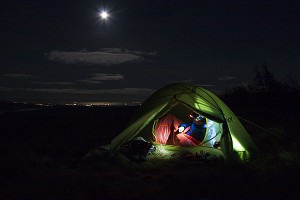
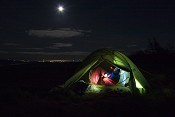
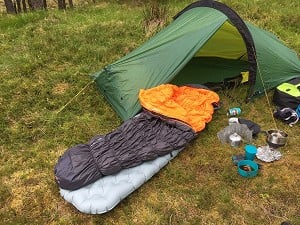
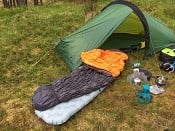
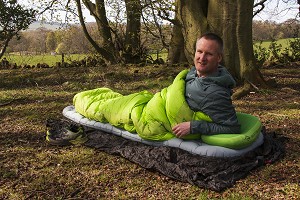
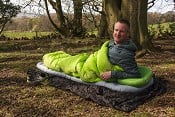

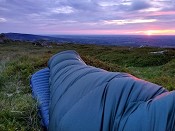
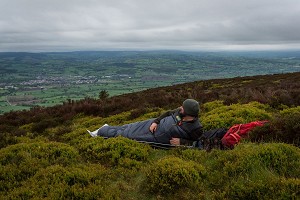
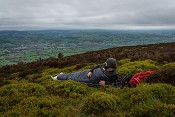

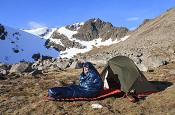

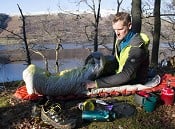


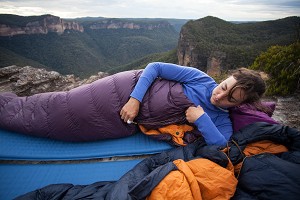
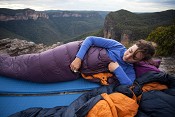
Comments